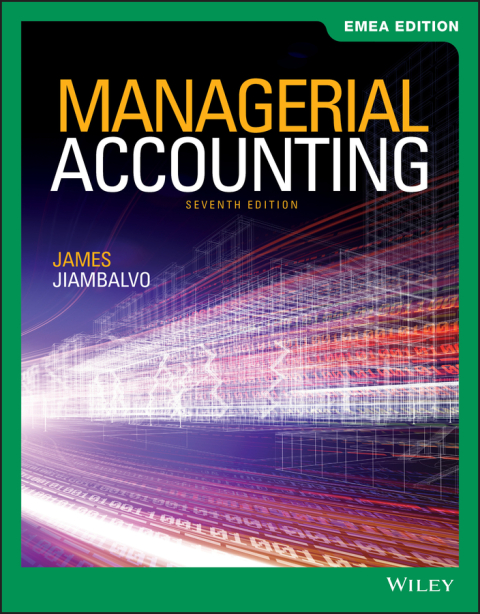Description
Efnisyfirlit
- Cover
- A Note to Students…
- About the Author
- What’s New?
- Preface
- WileyPLUS Resources
- Acknowledgments
- CHAPTER 1: Managerial Accounting in the Information Age
- Goal of Managerial Accounting
- Cost Terms Used in Discussing Planning, Control, and Decision Making
- Two Key Ideas in Managerial Accounting
- The Information Age and Managerial Accounting
- Ethical Considerations in Managerial Decision Making
- The Controller as the Top Management Accountant
- Chapter Review
- End-of-Chapter Homework
- APPENDIX: IMA Statement of Ethical Professional Practice
- CHAPTER 2: Job-Order Costing for Manufacturing and Service Companies
- Cost Classifications for Manufacturing Firms
- Product Cost Information in Financial Reporting and Decision Making
- Balance Sheet Presentation of Product Costs
- Flow of Product Costs in Accounts
- Income Statement Presentation of Product Costs
- Types of Costing Systems
- Overview of Job Costs and Financial Statement Accounts
- Job-Order Costing System
- Eastlake Revisited: Using Job Cost Information
- Relation Between the Costs of Jobs and the Flow of Costs in Work in Process, Finished Goods, and Cost of Goods Sold
- Allocating Overhead to Jobs: A Closer Look
- Predetermined Overhead Rates
- Job-Order Costing for Service Companies
- Modern Manufacturing Practices and Product Costing Systems
- Chapter Review
- End-of-Chapter Homework
- CHAPTER 3: Process Costing
- Difference between Job-Order and Process Costing Systems
- Product and Cost Flows
- Calculating Unit Cost
- Calculating and Applying Cost per Equivalent Unit: Mixing Department Example
- Production Cost Report
- Basic Steps in Process Costing: A Summary
- Kent Chemical Revisited: Answering Stacy’s Question
- Dealing with Transferred-in Cost: Packaging Department Example
- Process Costing and Incremental Analysis
- “You Get What You Measure!” and Manufacturing Processes
- Chapter Review
- End-of-Chapter Homework
- CHAPTER 4: Cost-Volume-Profit Analysis
- Common Cost Behavior Patterns
- Cost Estimation Methods
- Cost-Volume-Profit Analysis
- Multiproduct Analysis
- Assumptions in CVP Analysis
- Codeconnect Example Revisited: Answering Mary’s Questions
- Operating Leverage
- Constraints
- Chapter Review
- End-of-Chapter Homework
- APPENDIX: Using Regression in Microsoft Excel to Estimate Fixed and Variable Costs
- CHAPTER 5: Variable Costing
- Full (Absorption) and Variable Costing
- Effects of Production on Income for Full Versus Variable Costing: The Clausentube Example
- Benefits of Variable Costing for Internal Reporting
- Variable Costing Limits Management of Earnings via Production Volume
- Chapter Review
- End-of-Chapter Homework
- CHAPTER 6: Cost Allocation and Activity-Based Costing
- Purposes of Cost Allocation
- Process of Cost Allocation
- Allocating Service Department Costs
- Problems with Cost Allocation
- Activity-Based Costing
- Activity-Based Management
- Remember—You Get What You Measure!
- Chapter Review
- End-of-Chapter Homework
- APPENDIX: Activity-Based Management
- CHAPTER 7: The Use of Cost Information in Management Decision Making
- Incremental Analysis
- Analysis of Decisions Faced by Managers
- Decisions Involving Joint Costs
- Qualitative Considerations in Decision Analysis
- Chapter Review
- End-of-Chapter Homework
- APPENDIX: The Theory of Constraints
- CHAPTER 8: Pricing Decisions, Customer Profitability Analysis, and Activity-Based Pricing
- The Profit-Maximizing Price
- Pricing Special Orders
- Cost-Plus Pricing
- Target Costing
- Analyzing Customer Profitability: Revisiting the Priced Right Office Supplies Case
- Customer Profitability and Performance Measures
- Activity-Based Pricing
- Chapter Review
- End-of-Chapter Homework
- CHAPTER 9: Capital Budgeting and Other Long-Run Decisions
- Capital Budgeting Decisions
- Evaluating Investment Opportunities: Time Value of Money Approaches
- Considering “Soft” Benefits in Investment Decisions
- Estimating the Required Rate of Return
- Additional Cash Flow Considerations
- Other Long-Run Decisions
- Simplified Approaches to Capital Budgeting
- Conflict between Performance Evaluation and Capital Budgeting
- Wilson Air Example Revisited
- Chapter Review
- End-of-Chapter Homework
- APPENDIX A: Using Microsoft Excel to Calculate NPV and IRR
- APPENDIX B
- CHAPTER 10: Budgetary Planning and Control
- Use of Budgets in Planning and Control
- Developing the Budget
- The Master Budget
- Use of Computers in the Budget Planning Process
- Budgetary Control
- Investigating Budget Variances
- Conflict in Planning and Control Uses of Budgets
- Evaluation, Measurement, and Management Behavior
- The Preston Joystick Case Revisited
- Chapter Review
- End-of-Chapter Homework
- CHAPTER 11: Standard Costs and Variance Analysis
- Standard Costs
- A General Approach to Variance Analysis
- Material Variances
- Direct Labor Variances
- Overhead Variances
- Test Your Knowledge: Comprehensive Example
- Investigation of Standard Cost Variances
- Responsibility Accounting and Variances
- Chapter Review
- End-of-Chapter Homework
- APPENDIX: Recording Standard Costs in Accounts
- CHAPTER 12: Decentralization and Performance Evaluation
- Why Firms Decentralize
- Why Companies Evaluate the Performance of Subunits and Subunit Managers
- Cost Centers, Profit Centers, and Investment Centers
- Evaluating Investment Centers with ROI
- Evaluation Using Economic Value Added (EVA)
- Using a Balanced Scorecard to Evaluate Performance
- Developing a Strategy Map for a Balanced Scorecard
- Keys to a Successful Balanced Scorecard: Targets, Initiatives, Responsibility, Funding, Top Management Support
- Chapter Review
- End-of-Chapter Homework
- APPENDIX: Transfer Pricing
- CHAPTER 13: Statement of Cash Flows
- Need for a Statement of Cash Flows
- Types of Business Activities and the Classification of Cash Flows
- The Statement of Cash Flows Prepared Using the Direct Method
- Preparing the Statement of Cash Flows Using the Indirect Method
- Interpreting Information in the Statement of Cash Flows: The Situation at Ravira Restaurant Supply
- Chapter Review
- End-of-Chapter Homework
- CHAPTER 14: Analyzing Financial Statements: A Managerial Perspective
- Why Managers Analyze Financial Statements
- Horizontal and Vertical Analyses
- Earnings Management and the Need to Compare Earnings and Cash-Flow Information
- Other Sources of Information on Financial Performance
- Ratio Analysis
- A Managerial Perspective on the Analysis of Hgw’s Financial Statements
- Summary of Analyses
- Chapter Review
- End-of-Chapter Homework
- Glossary
- Index
- End User License Agreement





